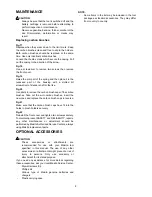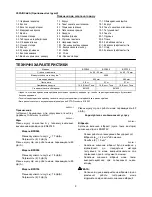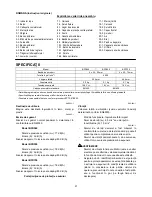
6
battery cartridge when you notice less tool
power.
2.
Never recharge a fully charged battery
cartridge.
Overcharging shortens the battery service life.
3.
Charge the battery cartridge with room
temperature at 10
゚
C - 40
゚
C (50
゚
F - 104
゚
F).
Let a hot battery cartridge cool down before
charging it.
4.
Charge the battery cartridge once in every six
months if you do not use it for a long period of
time.
FUNCTIONAL DESCRIPTION
CAUTION:
•
Always be sure that the tool is switched off and the
battery cartridge is removed before adjusting or
checking function on the tool.
Installing or removing battery cartridge
Fig.1
•
Always switch off the tool before installing or
removing of the battery cartridge.
•
To remove the battery cartridge, slide it from the
tool while sliding the button on the front of the
cartridge.
•
To install the battery cartridge, align the tongue on
the battery cartridge with the groove in the housing
and slip it into place. Always insert it all the way
until it locks in place with a little click. If you can see
the red indicator on the upper side of the button, it is
not locked completely. Install it fully until the red
indicator cannot be seen. If not, it may accidentally
fall out of the tool, causing injury to you or someone
around you.
•
Do not use force when installing the battery
cartridge. If the cartridge does not slide in easily, it
is not being inserted correctly.
Battery protection system (Lithium-ion
battery with star marking)
Fig.2
Lithium-ion batteries with a star marking are equipped
with a protection system. This system automatically cuts
off power to the tool to extend battery life.
The tool will automatically stop during operation if the tool
and/or battery are placed under one of the following
conditions:
•
Overloaded:
The tool is operated in a manner that causes
it to draw an abnormally high current.
In this situation, release the trigger switch on
the tool and stop the application that caused
the tool to become overloaded. Then pull the
trigger switch again to restart.
If the tool does not start, the battery is
overheated. In this situation, let the battery
cool before pulling the trigger switch again.
•
Low battery voltage:
The remaining battery capacity is too low and
the tool will not operate. In this situation,
remove and recharge the battery.
Setting for desired screw length
Fig.3
There are 7 positive-lock screw length settings. To obtain
the desired setting, pull out the stopper base while
depressing the lever until you see the number of the
desired screw length (indicated on the label on feeder
box) appear to rest in the fenestella of stopper base. See
the table below for the relation between the number
indicated on the label on feeder box and the respective
screw length.
For Models BFR540, BFR550
25
30
35
40
45
50
55
25 mm
30 mm
35 mm
40 mm
45 mm
50 mm
55 mm
Number indicated on the label
Screw length
008238
For Model BFR750
Number indicated on the label
Screw length
45
50
55
45 mm
50 mm
55 mm
60
65
70
75
60 mm
65 mm
70 mm
75 mm
008241
Adjusting the driving depth
Fig.4
Depress the stopper base as far as it will go. While
keeping it in this position, turn the adjusting knob until the
bit tip projects approx. 5 mm from the stopper base. Drive
a trial screw. If the screw head projects above the surface
of the workpiece, turn the adjusting knob in the "A"
direction; if the screw head is counter-sunk, turn the
adjusting knob in the "B" direction.
Switch action
Fig.5
CAUTION:
•
Before inserting the battery cartridge into the tool,
always check to see that the switch trigger actuates
properly and returns to the "OFF" position when
Summary of Contents for BFR540
Page 50: ...50 ...
Page 51: ...51 ...
Page 52: ...52 Makita Corporation Anjo Aichi Japan www makita com 884724B977 ...







































